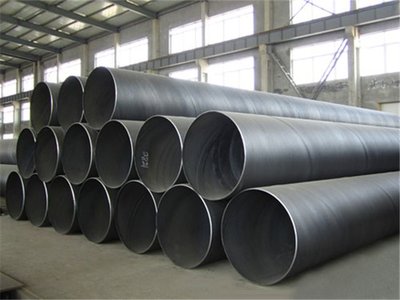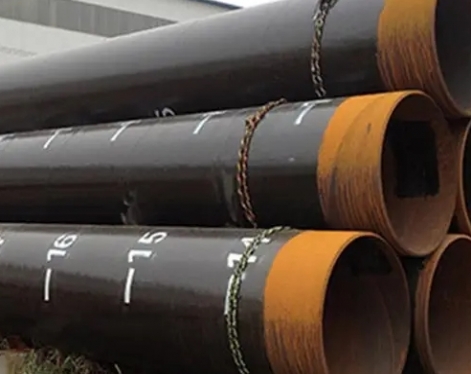What are the effects of coating on large diameter spiral steel pipe?
1. For large-diameter spiral steel pipe (SSAW pipe), if the outer protective pipe is polyethylene pipe, there is no need to make anti-corrosion polyethylene. This kind of steel pipe is odorless, non-toxic, feels like wax, and has excellent low temperature resistance (the lowest operating temperature can reach -70~-100°C). Good chemical stability, corrosion resistance to most acids and bases (not resistant to acids with oxidizing properties), insoluble in common solvents at room temperature, and low water absorption. However, because it is a linear molecule, it can be slowly dissolved in some organic solvents without swelling, and has excellent electrical insulation performance.
Coating anti-corrosion of large-diameter spiral steel pipe is to apply paint uniformly and densely on the surface of the derusted metal pipe to isolate it from various corrosive media. It is one of the fundamental methods for large-diameter spiral steel pipe anti-corrosion. Steel pipe anti-corrosion coatings are increasingly using composite materials or composite structures. These materials and structures must have good dielectric properties, physical properties, stable chemical properties, and a wide temperature range.

2. Anti-corrosion coating on the outer wall of large-diameter spiral steel pipe: the types and conditions of use of the coating on the outer wall of the pipe.
① Inner wall anti-corrosion coating: a film applied to the inner wall of the pipe in order to prevent corrosion inside the pipe, reduce frictional resistance, and increase throughput. Commonly used coatings include amine-cured epoxy resin and polyamide epoxy resin, and the coating thickness is 0.038 to 0.2 mm. In order for the coating to bond firmly with the pipe wall, it is necessary to carry out surface treatment on the inner wall of the pipe. Since the 1970s, the same material has been used for the coating of the inner and outer walls of the pipe, so that the coating of the inner and outer walls of the pipe can be carried out at the same time.
②Large-diameter spiral steel pipe anti-corrosion and thermal insulation coating: On medium and small-caliber octg pipes for thermally transporting crude oil or fuel oil, in order to reduce heat dissipation from the pipeline to the soil, a composite layer of thermal insulation and anticorrosion is added to the outside of the pipeline. The commonly used thermal insulation material is rigid polyurethane foam, and the applicable temperature is -185~95℃. This material is soft in texture. In order to improve its strength, a layer of high-density polyethylene is applied outside the heat insulation layer to form a composite material structure to prevent groundwater from penetrating into the insulation layer.
1. For large-diameter spiral steel pipe (SSAW pipe), if the outer protective pipe is polyethylene pipe, there is no need to make anti-corrosion polyethylene. This kind of steel pipe is odorless, non-toxic, feels like wax, and has excellent low temperature resistance (the lowest operating temperature can reach -70~-100°C). Good chemical stability, corrosion resistance to most acids and bases (not resistant to acids with oxidizing properties), insoluble in common solvents at room temperature, and low water absorption. However, because it is a linear molecule, it can be slowly dissolved in some organic solvents without swelling, and has excellent electrical insulation performance.
Coating anti-corrosion of large-diameter spiral steel pipe is to apply paint uniformly and densely on the surface of the derusted metal pipe to isolate it from various corrosive media. It is one of the fundamental methods for large-diameter spiral steel pipe anti-corrosion. Steel pipe anti-corrosion coatings are increasingly using composite materials or composite structures. These materials and structures must have good dielectric properties, physical properties, stable chemical properties, and a wide temperature range.

2. Anti-corrosion coating on the outer wall of large-diameter spiral steel pipe: the types and conditions of use of the coating on the outer wall of the pipe.
① Inner wall anti-corrosion coating: a film applied to the inner wall of the pipe in order to prevent corrosion inside the pipe, reduce frictional resistance, and increase throughput. Commonly used coatings include amine-cured epoxy resin and polyamide epoxy resin, and the coating thickness is 0.038 to 0.2 mm. In order for the coating to bond firmly with the pipe wall, it is necessary to carry out surface treatment on the inner wall of the pipe. Since the 1970s, the same material has been used for the coating of the inner and outer walls of the pipe, so that the coating of the inner and outer walls of the pipe can be carried out at the same time.
②Large-diameter spiral steel pipe anti-corrosion and thermal insulation coating: On medium and small-caliber octg pipes for thermally transporting crude oil or fuel oil, in order to reduce heat dissipation from the pipeline to the soil, a composite layer of thermal insulation and anticorrosion is added to the outside of the pipeline. The commonly used thermal insulation material is rigid polyurethane foam, and the applicable temperature is -185~95℃. This material is soft in texture. In order to improve its strength, a layer of high-density polyethylene is applied outside the heat insulation layer to form a composite material structure to prevent groundwater from penetrating into the insulation layer.









